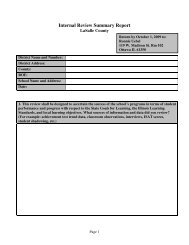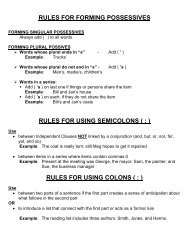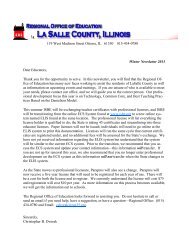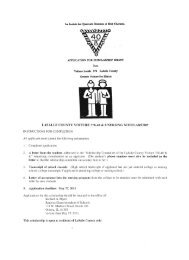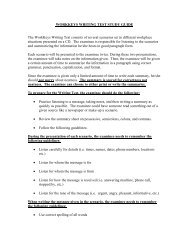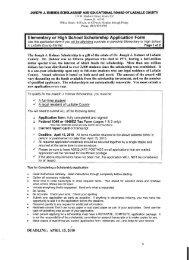Explicit Instruction - Example Lessons - Lease
Explicit Instruction - Example Lessons - Lease
Explicit Instruction - Example Lessons - Lease
Create successful ePaper yourself
Turn your PDF publications into a flip-book with our unique Google optimized e-Paper software.
partial answer.<br />
Body of Lesson<br />
Introduction to the strategy. Let’s learn about the strategy for answering written questions. (Teacher<br />
points to the strategy.) Read Step #1. Read the item. Yes, first you would read the question carefully.<br />
Read Step #2. Turn the question into part of the answer and write it down. This is the skill that we have<br />
been practicing . . . using words from the question in the answer. Read Step #3. Think of the answer or<br />
locate the answer in the article. Sometimes you know the answer, but often you will need to look back<br />
in the article or chapter to locate an answer or additional examples to explain your answer. Read Step<br />
#4. Complete the answer. Now, you are ready to complete your answer. Read Step #5. Reread your<br />
answer. Ask yourself: Does it make sense? Are all parts of the question answered? Of course, when<br />
you are done you should reread your answer to be sure that it makes sense and is complete.<br />
Modeling (I do it.) My turn to use the strategy. Read Step #1. Read the item. (Teacher displays<br />
question.) Read the question with me. When Gandhi lived in South Africa, what were some of his acts<br />
of nonviolent resistance? Read the Step #2. Turn the question into part of the answer and write it<br />
down. This is my partial answer. (Teacher displays partial answer.) Read it with me. When living in<br />
South Africa, Gandhi engaged in a number of acts of nonviolent resistance. Notice that I used words<br />
from the question in the partial answer. Read Step #3. Think of the answer or locate the answer in the<br />
article. I am going to look back in the article. (Teacher looks at the article.) Here is one example . . .<br />
Gandhi refused to move to third class seats on the train and was finally thrown off the train. In the next<br />
section, the article tells about Gandhi refusing to get off the stagecoach even when he was beaten. Now<br />
I have ideas for the answer. Read Step #4. Complete your answer. (Teacher displays completed<br />
answer.) Read my completed answer. When living in South Africa, Gandhi engaged in a number of acts<br />
of nonviolent resistance. In one incident, Gandhi purchased a first class train ticket but was told to








